Mainshock Anticipated by Intra-Sequence Ground Deformations: Insights from Multiscale Field and SAR Interferometric Measurements
Abstract
1. Introduction
2. Materials and Methods
2.1. Fault-Slip Data Collection and Strain Markers
2.2. DInSAR Processing
2.3. Measurements of Length of the Deforming Ground
2.4. Procedure for Estimating the Fault Rupture Area
2.5. Evaluation of the Expected Earthquake Magnitude
3. Results
3.1. Intra-Sequence Ground Deformation Measured in the Field
3.2. IGD from DInSAR Analysis
3.3. Estimates of LDG
3.4. Assessments of Coseismic Rupture Area and Associate Magnitude
4. Discussion
5. Conclusions
Supplementary Materials
Author Contributions
Funding
Acknowledgments
Conflicts of Interest
Software Used in This Work
References
- Lavecchia, G.; Castaldo, R.; Nardis, R.; De Novellis, V.; Ferrarini, F.; Pepe, S.; Brozzetti, F.; Solaro, G.; Cirillo, D.; Bonano, M.; et al. Ground deformation and source geometry of the 24 August 2016 Amatrice earthquake (Central Italy) investigated through analytical and numerical modeling of DInSAR measurements and structural-geological data. Geophys. Res. Lett. 2016, 43, 12389–12398. [Google Scholar] [CrossRef]
- Tinti, E.; Scognamiglio, L.; Michelini, A.; Cocco, M. Slip heterogeneity and directivity of the ML 6.0, 2016, Amatrice earthquake estimated with rapid finite-fault inversion. Geophys. Res. Lett. 2016, 43, 10745–10752. [Google Scholar] [CrossRef]
- Chiaraluce, L.; Di Stefano, R.; Tinti, E.; Scognamiglio, L.; Michele, M.; Casarotti, E.; Cattaneo, M.; De Gori, P.; Chiarabba, C.; Monachesi, G.; et al. The 2016 Central Italy Seismic Sequence: A First Look at the Mainshocks, Aftershocks, and Source Models. Seismol. Res. Lett. 2017, 88, 757–771. [Google Scholar] [CrossRef]
- Brozzetti, F.; Boncio, P.; Cirillo, D.; Ferrarini, F.; De Nardis, R.; Testa, A.; Liberi, F.; Lavecchia, G. High-resolution field mapping and analysis of the August–October 2016 coseismic surface faulting (central Italy earthquakes): Slip distribution, parameterization, and comparison with global earthquakes. Tectonics 2019, 38, 417–439. [Google Scholar] [CrossRef]
- Calamita, F.; Pizzi, A.; Roscioni, M. I fasci di faglie recenti ed attive di M. Vettore–M. Bove e di M. Castello–M. Cardosa (Appennino Umbro-Marchigiano). In Studi Geologici Camerti; Università di Camerino: Camerino, Italy, 1992; pp. 81–95. Available online: http://193.204.8.201:8080/jspui/handle/1336/552 (accessed on 14 May 2020).
- Brozzetti, F.; Lavecchia, G. Seismicity and related extensional stress field: The case of the Norcia seismic zone (Central Italy). Ann. Tecton. 1994, 8, 36–57. [Google Scholar]
- Galadini, F.; Galli, P. Paleoseismology of silent faults in the Central Apennines (Italy): The Mt Vettore and Laga Mts. Faults. Ann. Geophys. 2003, 46, 815–836. [Google Scholar]
- Boncio, P.; Lavecchia, G.; Pace, B. Defining a model of 3D seismogenic sources for seismic hazard assessment applications: The case of central Apennines (Italy). J. Seismol. 2004, 8, 407–425. [Google Scholar] [CrossRef]
- Michele, M.; Di Stefano, R.; Chiaraluce, L.; Cattaneo, M.; De Gori, P.; Monachesi, G.; Latorre, D.; Marzorati, S.; Valoroso, L.; Ladina, C.; et al. The Amatrice 2016 seismic sequence: A preliminary look at the mainshock and aftershocks distribution. Ann. Geophys. 2016, 59. [Google Scholar] [CrossRef]
- Sentinel-1 INSAR Performance Study with TOPS Data. Available online: http://insarap.org/ (accessed on 14 May 2020).
- COMET Interferograms of the 2016 Apennines Earthquakes and Aftershocks, Italy. Available online: http://comet.nerc.ac.uk/latest-earthquakes-and-eruptions/apennines-earthquakes-aftershocks-italy/ (accessed on 14 May 2020).
- Villani, F.; Open EMERGEO Working Group. A database of the coseismic effects following the 30 October 2016 Norcia earthquake in Central Italy. Sci. Data 2018, 5, 180049. [Google Scholar] [CrossRef]
- De Guidi, G.; Vecchio, A.; Brighenti, F.; Caputo, R.; Carnemolla, F.; Di Pietro, A.; Lupo, M.; Maggini, M.; Marchese, S.; Messina, D.; et al. Co-seismic displacement on 26 and 30 October 2016 (Mw D 5:9 and 6.5)—Earthquakes in central Italy from the analysis of a local GNSS network. Nat. Hazards Earth Syst. Sci. 2017, 17, 1885–1892. [Google Scholar] [CrossRef]
- Mildon, Z.K.; Roberts, G.P.; Faure Walker, J.P.; Iezzi, F. Coulomb stress transfer and fault interaction over millennia on non-planar active normal faults: The Mw 6.5-5.0 seismic sequence of 2016–2017, central Italy. Geophys. J. Int. 2017, 210, 1206–1218. [Google Scholar] [CrossRef]
- Salvi, S.; Stramondo, S.; Funning, G.J.; Ferretti, A.; Sarti, F.; Mouratidis, A. The Sentinel-1 mission for the improvement of the scientific understanding and the operational monitoring of the seismic cycle. Remote Sens. Environ. 2012, 120, 164–174. [Google Scholar] [CrossRef]
- Massonnet, D.; Feigl, K.; Rossi, M.; Adragna, F. Radar interferometric mapping of deformation in the year after the Landers earthquake. Nature 1994, 369, 227–230. [Google Scholar] [CrossRef]
- Goldstein, R.M.; Werner, C.L. Radar interferogram filtering for geophysical application. Geophys. Res. Lett. 1998, 25, 4035–4038. [Google Scholar] [CrossRef]
- SNAPHU: Statistical-Cost, Network-Flow Algorithm for Phase Unwrapping. Available online: https://web.stanford.edu/group/radar/softwareandlinks/sw/snaphu/ (accessed on 14 May 2020).
- Chiaraluce, L.; Ellsworth, W.L.; Chiarabba, C.; Cocco, M. Imaging the complexity of an active normal fault system: The 1997 Colfiorito (central Italy) case study. J. Geophys. Res. 2003, 108, 1–19. [Google Scholar] [CrossRef]
- Chiaraluce, L.; Barchi, M.; Collettini, C.; Mirabella, F.; Pucci, S. Connecting seismically active normal faults with Quaternary geological structures in a complex extensional environment: The Colfiorito 1997 case history (northern Apennines, Italy). Tectonics 2005, 24, TC1002. [Google Scholar] [CrossRef]
- Chiaraluce, L.; Valoroso, L.; Piccinini, D.; Di Stefano, R.; De Gori, P. The anatomy of the 2009 L’Aquila normal fault system (central Italy) imaged by high resolution foreshock and aftershock locations. J. Geophys. Res. 2011, 116, B12311. [Google Scholar] [CrossRef]
- Lavecchia, G.; Boncio, P.; Brozzetti, F.; De Nardis, R.; Di Naccio, D.; Ferrarini, F.; Pizzi, A.; Pomposo, G. The April 2009 Aquila (Central Italy) Seismic Sequence (Mw6.3): A Preliminary Seismotectonic Picture. In Recent Progress on Earthquake Geology; Guarnieri, P., Ed.; Special Publ.; Nova Sciences Publishers Inc.: New York, NY, USA, 2011. [Google Scholar]
- Stramondo, S.; Tesauro, M.; Briole, P.; Sansosti, E.; Salvi, S.; Lanari, R.; Anzidei, M.; Baldi, P.; Fornaro, G.; Avallone, A.; et al. The September 26, 1997 Colfiorito, Italy, earthquakes: Modeled coseismic surface displacement from SAR interferometry and GPS. Geophys. Res. Lett. 1999, 26, 883–886. [Google Scholar] [CrossRef]
- De Natale, G.; Crippa, B.; Troise, C.; Pingue, F. Abruzzo, Italy, Earthquakes of April 2009: Heterogeneous Fault-Slip Models and Stress Transfer from Accurate Inversion of ENVISAT-InSAR Data. Bull. Seismol. Soc. Am. 2011, 101, 2340–2354. [Google Scholar] [CrossRef]
- Cirella, A.; Piatanesi, A.; Cocco, M.; Tinti, E.; Scognamiglio, L.; Michelini, A.; Lomax, A.; Boschi, E. Rupture history of the 2009 L’Aquila (Italy) earthquake from non-linear joint inversion of strong motion and GPS data. Geophys. Res. Lett. 2009, 36, L19304. [Google Scholar] [CrossRef]
- Wells, D.L.; Coppersmith, J. New empirical relationships among magnitude, rupture length, rupture width, rupture area, and surface displacement. Bull. Seismol. Soc. Am. 1994, 84, 974–1002. [Google Scholar]
- Leonard, M. Earthquake fault scaling: Selfconsistent relating of rupture length, width, average displacement and moment release. Bull. Seismol. Soc. Am. 2010, 100, 1971–1988. [Google Scholar] [CrossRef]
- Stirling, M.; Goded, T.; Berryman, K.; Litchfield, N. Selection of earthquake scaling relationships for seismic hazard analysis. Bull. Seismol. Soc. Am. 2013, 103, 1–19. [Google Scholar] [CrossRef]
- Tolomei, C.; Salvi, S.; Merryman Boncori, J.P.; Pezzo, G. InSAR measurement of crustal deformation transients during the earthquake preparation processes: A review. Boll. Geofis. Teor. Appl. 2015, 56, 151–166. [Google Scholar] [CrossRef]
- Chiarabba, C.; De Gori, P.; Cattaneo, M.; Spallarossa, D.; Segou, M. Faults geometry and the role of fluids in the 2016–2017 Central Italy seismic sequence. Geophys. Res. Lett. 2018, 45, 6963–6971. [Google Scholar] [CrossRef]
- Xu, G.; Xu, C.; Wen, Y.; Jiang, G. Source parameters of the 2016-2017 Central Italy Earthquake Sequence from the Sentinel-1, ALOS-2 and GPS data. Remote Sens. 2017, 9, 1182. [Google Scholar] [CrossRef]
- Porreca, M.; Minelli, G.; Ercoli, M.; Brobia, A.; Mancinelli, P.; Cruciani, F.; Giorgetti, C.; Carboni, F.; Mirabella, F.; Cavinato, G.; et al. Seismic reflection profiles and subsurface geology of the area interested by the 2016–2017 earthquake sequence (Central Italy). Tectonics 2018, 37, 1116–1137. [Google Scholar] [CrossRef]
- Mancinelli, P.; Porreca, M.; Pauselli, C.; Minelli, G.; Barchi, M.R.; Speranza, F. Gravity and Magnetic Modeling of Central Italy: Insights into the Depth Extent of the Seismogenic Layer. Geochem. Geophys. Geosyst. 2019, 20, 2157–2172. [Google Scholar] [CrossRef]
- Vittori, E.; Deiana, G.; Esposito, E.; Ferreli, L.; Marchegiani, L.; Mastrolorenzo, G.; Michetti, A.M.; Porfido, S.; Serva, L.; Simonelli, A.L.; et al. Ground effects and surface faulting in the September-October 1997 Umbria-Marche (Central Italy) seismic sequence. J. Geodyn. 2000, 29, 535–564. [Google Scholar] [CrossRef]
- Cello, G.; Deiana, G.; Ferelli, L.; Marchegiani, L.; Maschio, L.; Mazzoli, S.; Michetti, A.; Serva, L.; Tondi, E.; Vittori, T. Geological constraints for earthquake faulting studies in the Colfiorito area (Central Italy). J. Seismol. 2000, 4, 357–364. [Google Scholar] [CrossRef]
- Boncio, P.; Pizzi, A.; Brozzetti, F.; Pomposo, G.; Lavecchia, G.; Di Naccio, D.; Ferrarini, F. Coseismic ground deformation of the 6 April 2009 L’Aquila earthquake (Central Italy, Mw 6.3). Geophys. Res. Lett. 2010, 37, L06308. [Google Scholar] [CrossRef]
- Lavecchia, G.; Ferrarini, F.; Brozzetti, F.; De Nardis, R.; Boncio, P.; Chiaraluce, L. From surface geology to aftershock analysis: Constraints on the geometry of the L’Aquila 2009 seismogenic fault system. Ital. J. Geosci. 2012, 131, 330–347. [Google Scholar] [CrossRef]
- Lavecchia, G.; Adinolfi GM de Nardis, R.; Ferrarini, F.; Cirillo DBrozzetti De Matteis, R.; Festa, G.; Zollo, A. Multidisciplinary inferences on a newly recognized active east-dipping extensional system in Central Italy. Terra Nova 2017, 29, 77–89. [Google Scholar] [CrossRef]
- Ferrarini, F.; Lavecchia, G.; de Nardis, R.; Brozzetti, F. Fault geometry and active stress from earthquakes and field geology data analysis: The Colfiorito 1997 and L’Aquila 2009 cases (Central Italy). Pure Appl. Geophys. 2015, 172, 1079–1103. [Google Scholar] [CrossRef]
- Castaldo, R.; de Nardis, R.; DeNovellis, V.; Ferrarini, F.; Lanari, R.; Lavecchia, G.; Pepe, S.; Solaro, G.; Tizzani, P. Coseismic stress and strain field changes investigation through 3-D Finite Element modeling of DInSAR and GPS measurements and geological/seismological data: The L’Aquila (Italy) 2009 earthquake case study. J. Geophys. Res. Solid Earth 2018, 123, 4193–4222. [Google Scholar] [CrossRef]
- Wilkinson, M.; McCaffrey KJ, W.; Roberts, G.; Cowie, P.A.; Phillips, R.J.; Michetti, A.M.; Vittori, E.; Guerrieri, L.; Blumetti, A.M.; Bubeck, A.; et al. Partitioned post seismic deformation associated with the 2009 Mw 6.3 L’Aquila earthquake surface rupture measured using a terrestrial laser scanner. Geophys. Res. Lett. 2010, 37, L10309. [Google Scholar] [CrossRef]
- Lanari, R.; Berardino, P.; Bonano, M.; Casu, F.; Manconi, A.; Manunta, M.; Manzo, M.; Pepe, A.; Pepe, S.; Sansosti, E.; et al. Surface displacements associated with the L’Aquila 2009 Mw 6.3 earthquake (central Italy): New evidence from SBAS-DInSAR time series analysis. Geophys. Res. Lett. 2010, 37, L20309. [Google Scholar] [CrossRef]
- Chen, C.W.; Zebker, H.A. Phase unwrapping for large SAR interferograms: Statistical segmentation and generalized network models. IEEE Trans. Geosci. Remote Sens. 2002, 40, 1709–1719. [Google Scholar] [CrossRef]
- Scheiber, R.; Moreira, A. Coregistration of Interferometric SAR Images Using Spectral Diversity. IEEE Trans. Geosci. Remote Sens. 2000, 38, 2179–2191. [Google Scholar] [CrossRef]
- Barra, A.; Monserrat, O.; Mazzanti, P.; Esposito, C.; Crosetto, M.; Scarascia Mugnozza, G. First insights on the potential of Sentinel-1 for landslides detection. Geomat. Nat. Hazards Risk 2016, 7, 1874–1883. [Google Scholar] [CrossRef]
- Albano, M.; Saroli, M.; Moro, M.; Falcucci, E.; Gori, S.; Stramondo, S.; Galadini, F.; Barba, S. Minor shallow gravitational component on the Mt. Vettore surface ruptures related to MW 6, 2016 Amatrice earthquake. Ann. Geophys. 2016, 59. [Google Scholar] [CrossRef]
- Walters, R.J.; Gregory, L.C.; Wedmore, L.N.; Craig, T.J.; McCaffrey, K.; Wilkinson, M.; Chen, J.; Li, Z.; Elliott, J.R.; Goodall, H.; et al. Dual control of fault intersections on stop-start rupture in the 2016 Central Italy seismic sequence. Earth Planet. Sci. Lett. 2018, 500, 1–14. [Google Scholar] [CrossRef]
- Bucknam, R.C.; Plafker, G.; Sharp, R.V. Fault movement (afterslip) following the Guatemala earthquake of February 4, 1976. Geology 1978, 6, 170–173. [Google Scholar] [CrossRef]
- Marone, C.J.; Scholz, C.H.; Bilham, R. On the mechanics of earthquake afterslip. J. Geophys. Res. 1991, 96, 8441–8452. [Google Scholar] [CrossRef]
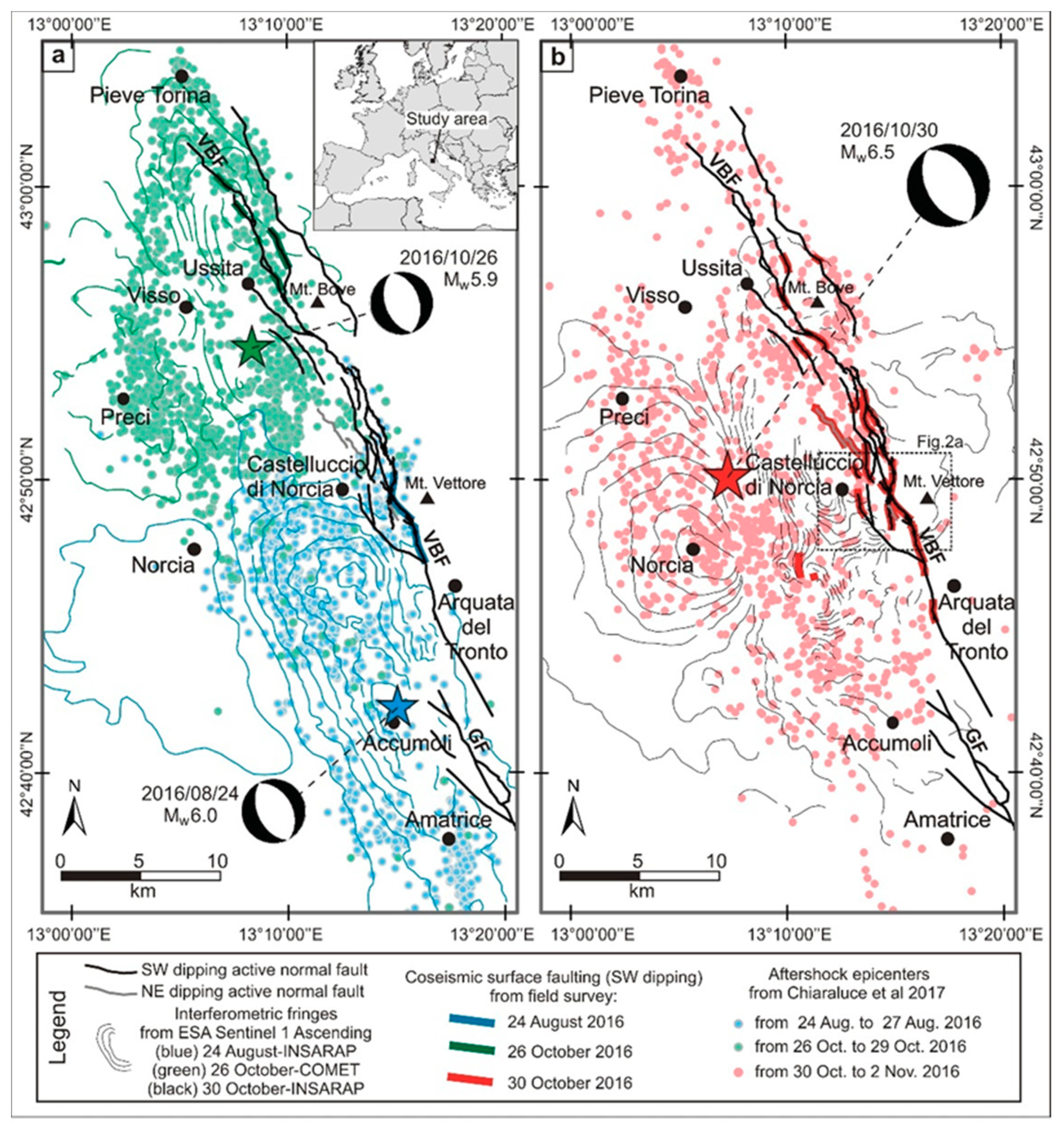
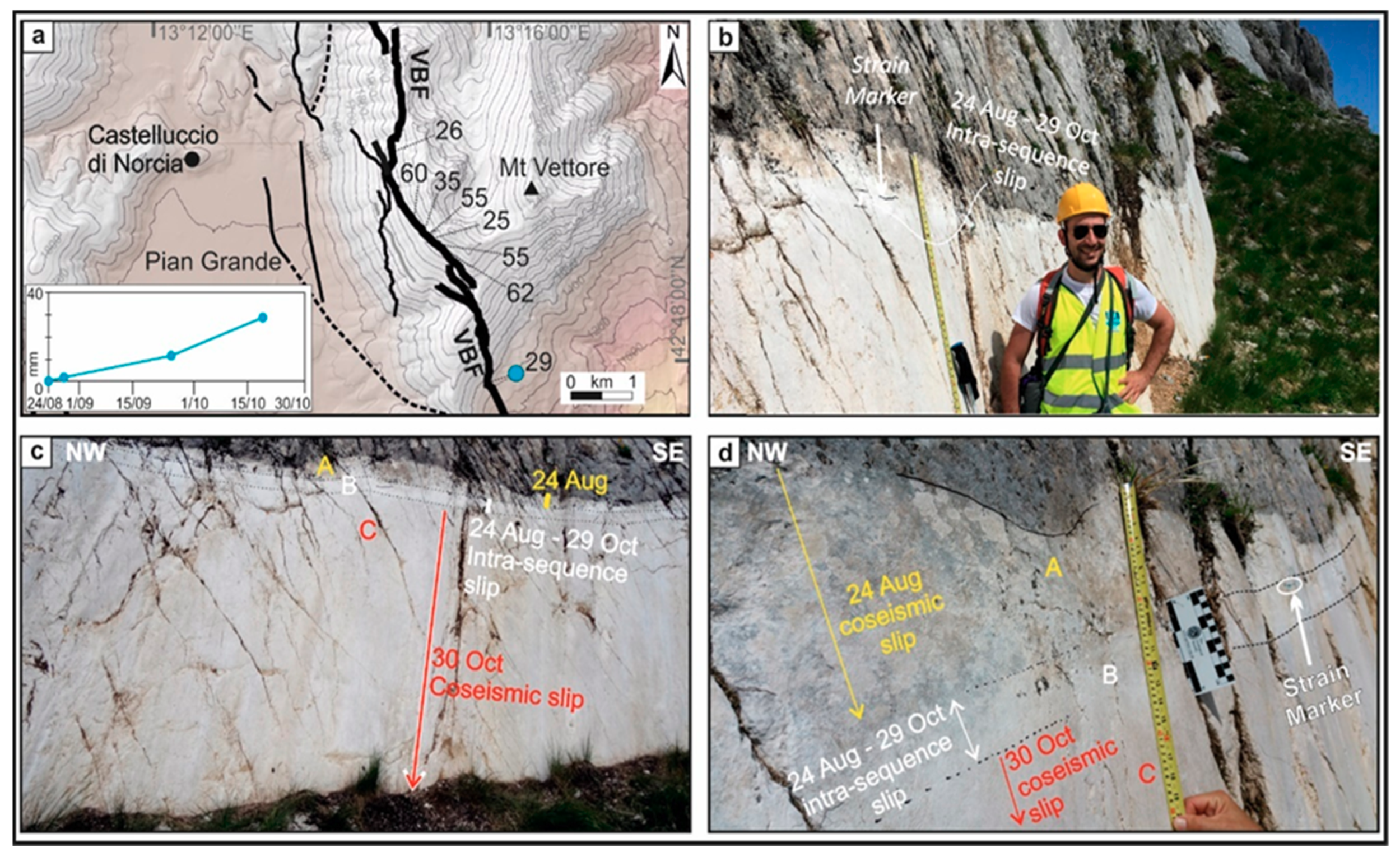
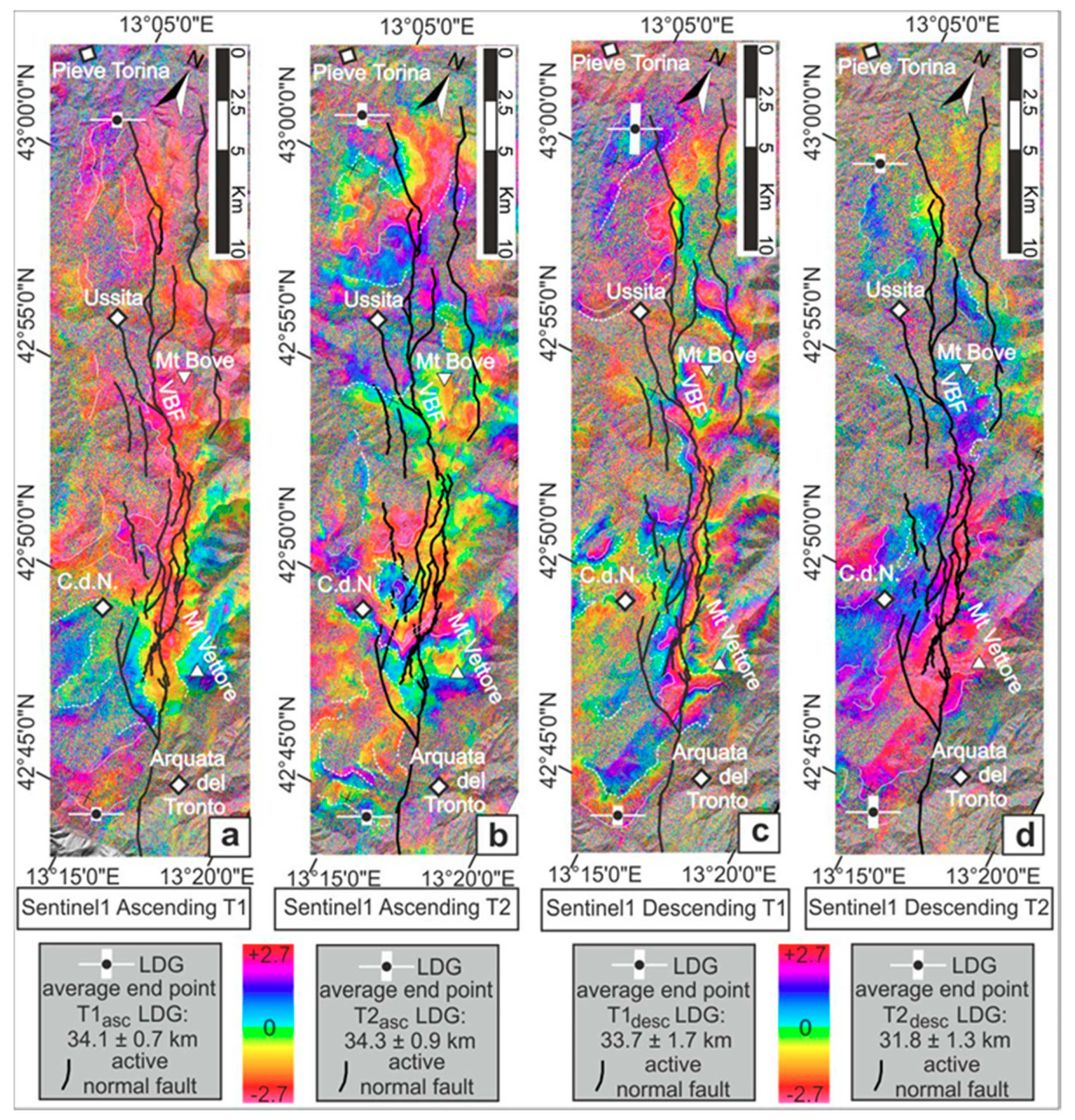
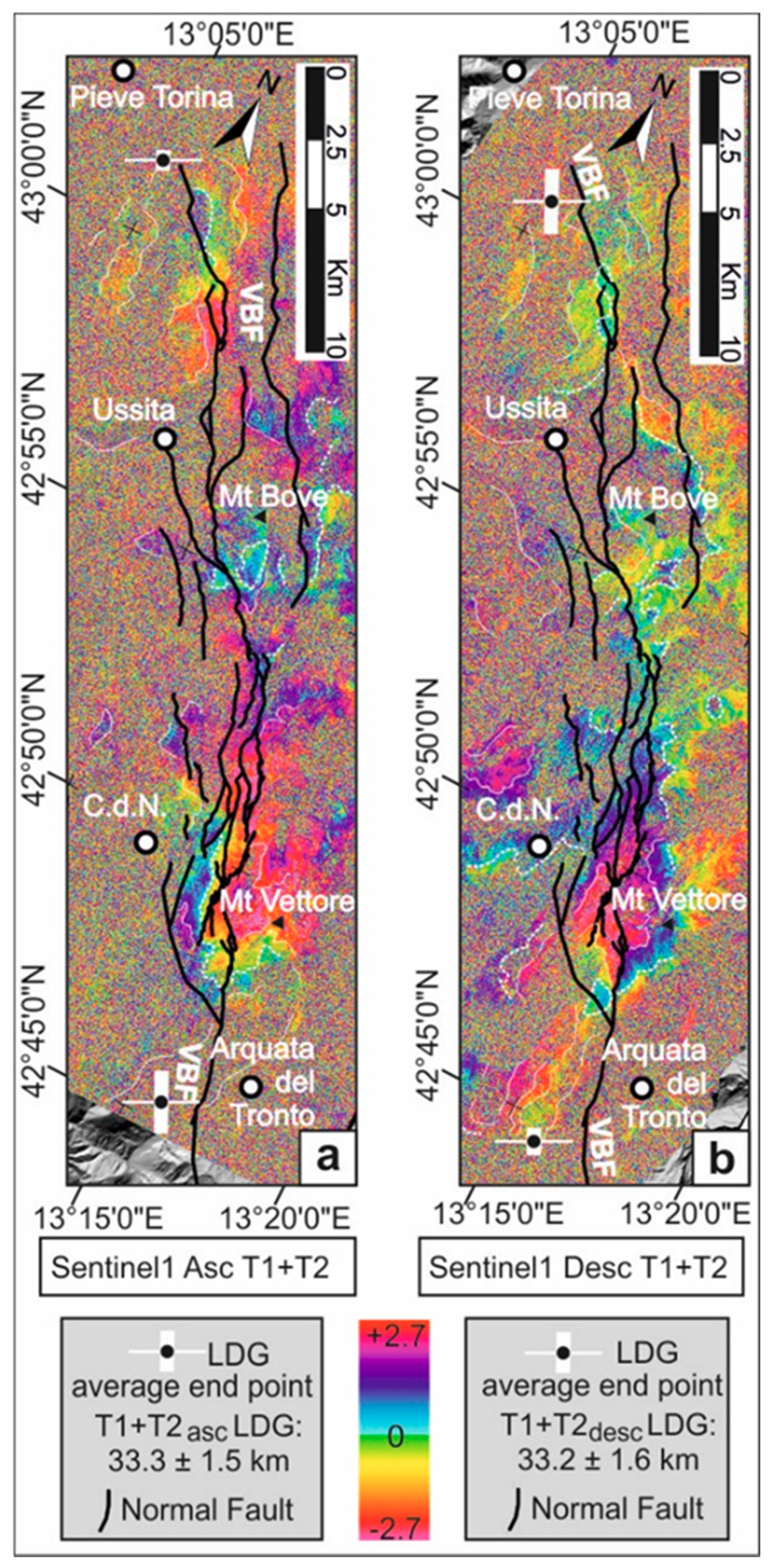
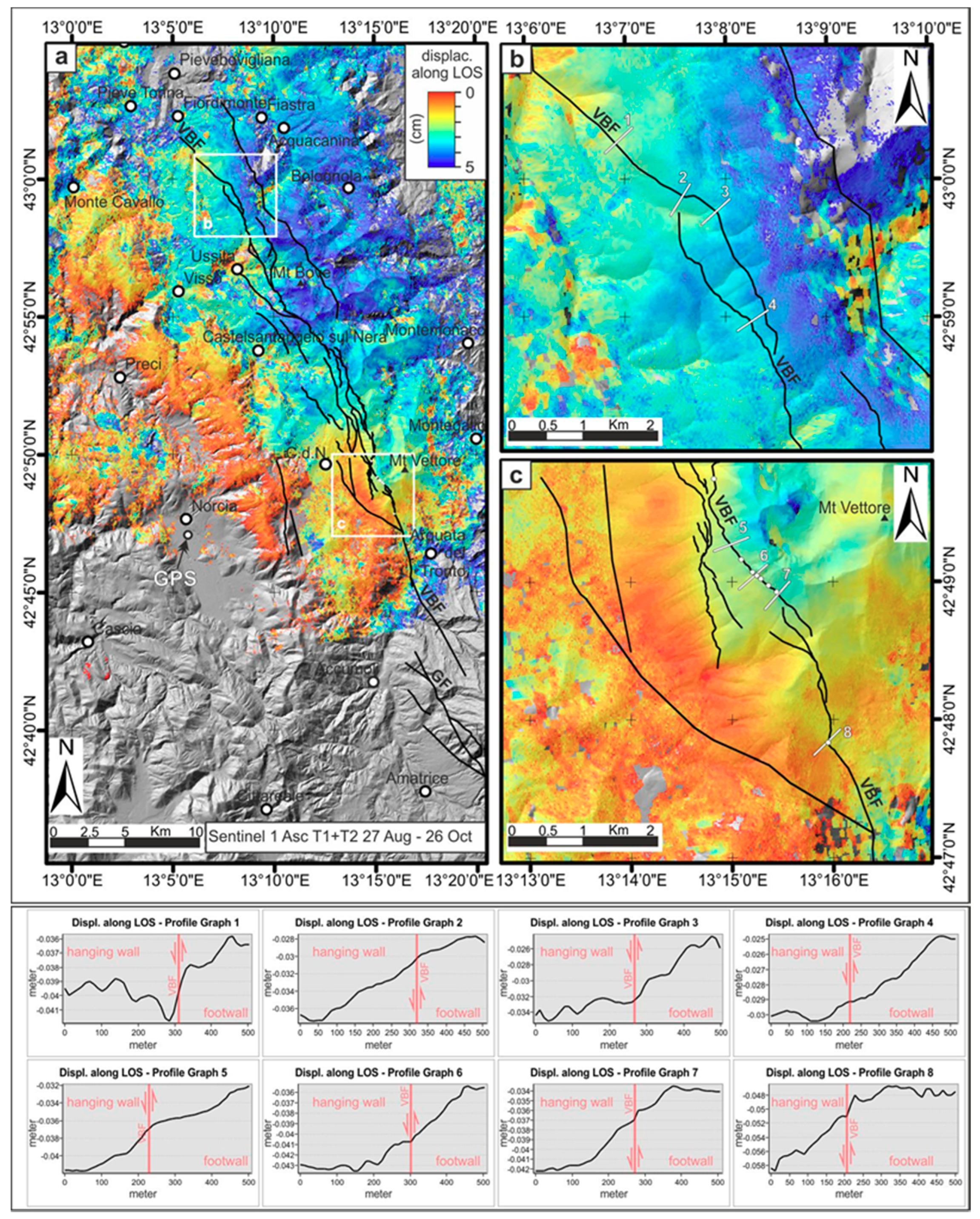
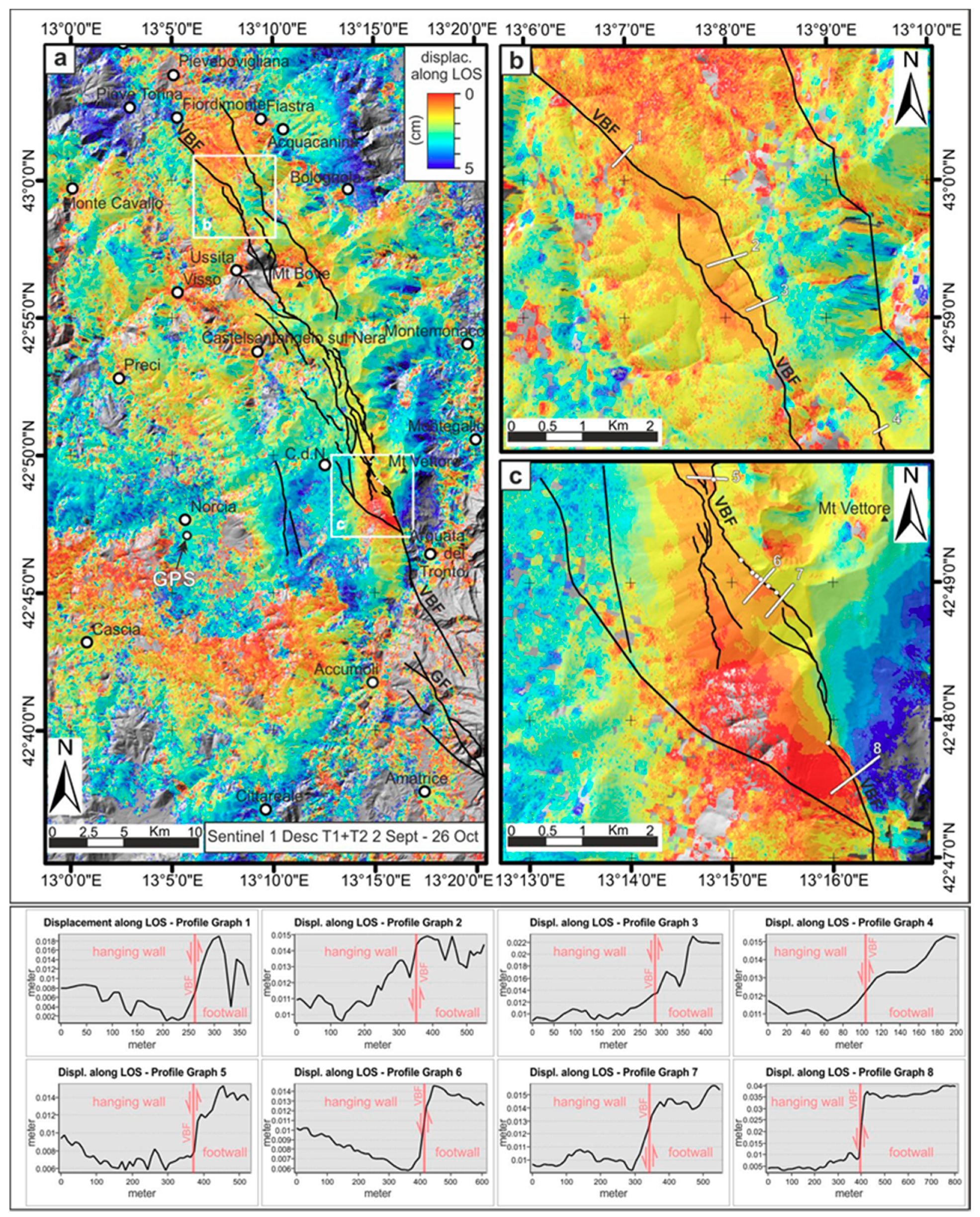
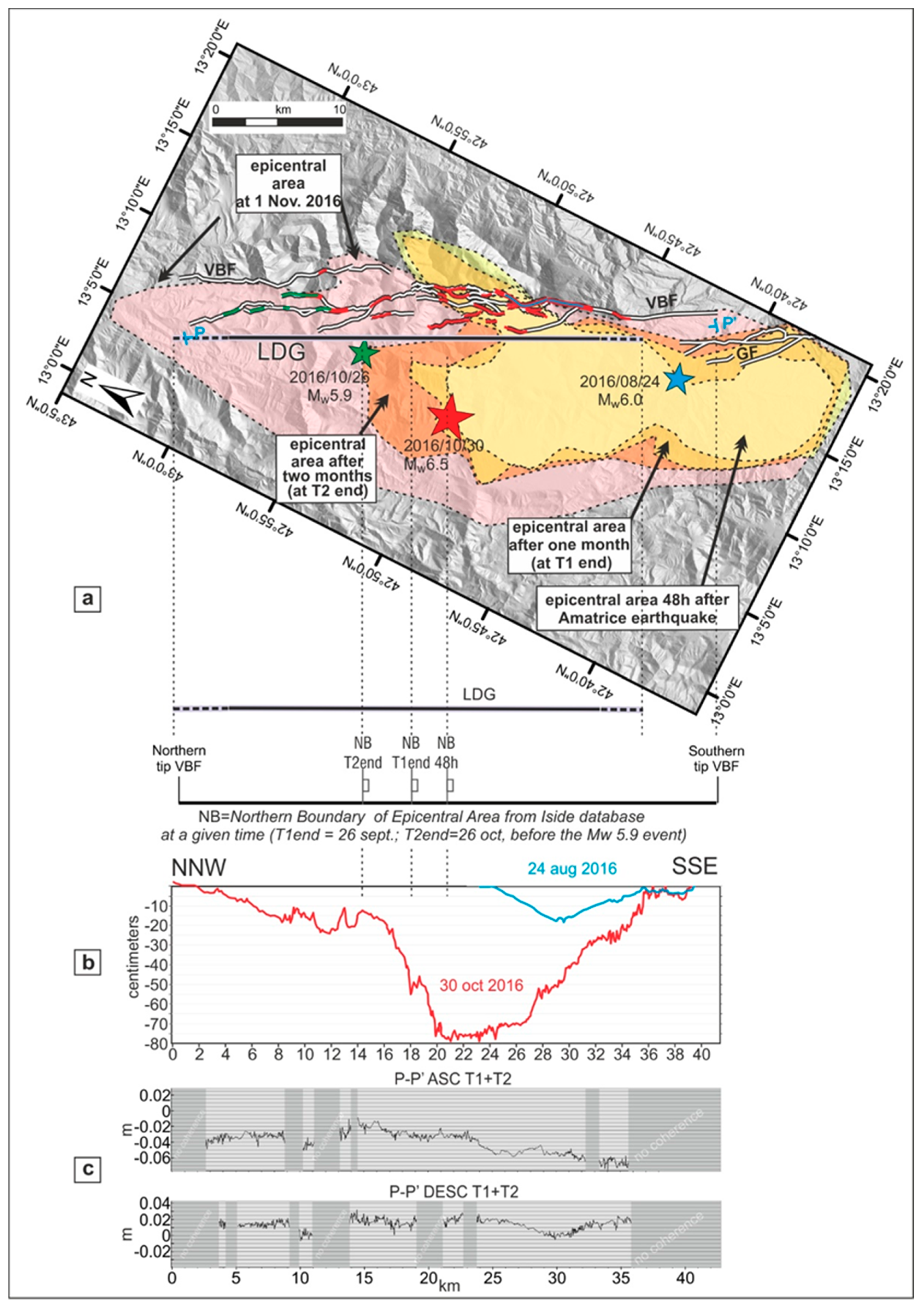
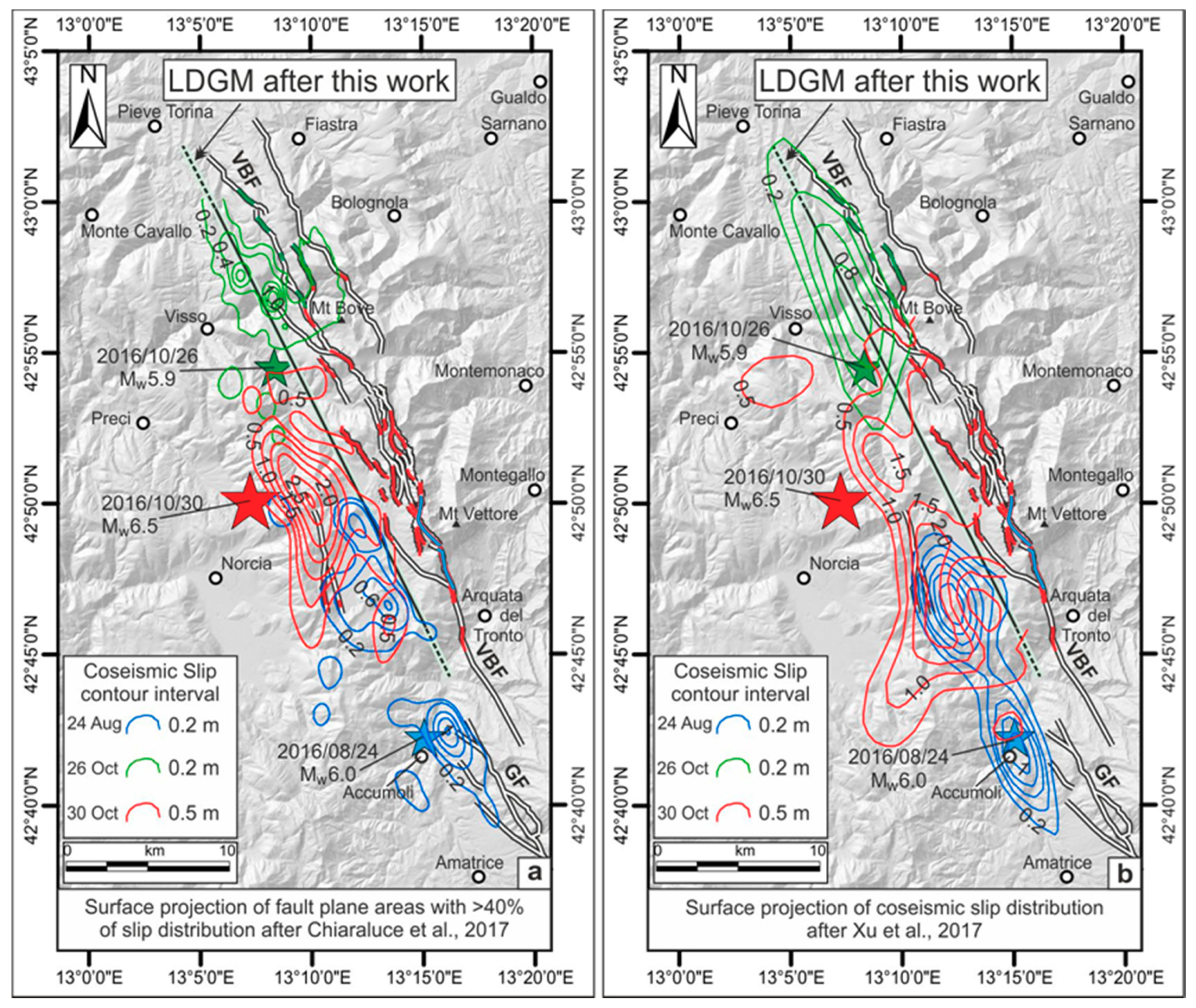
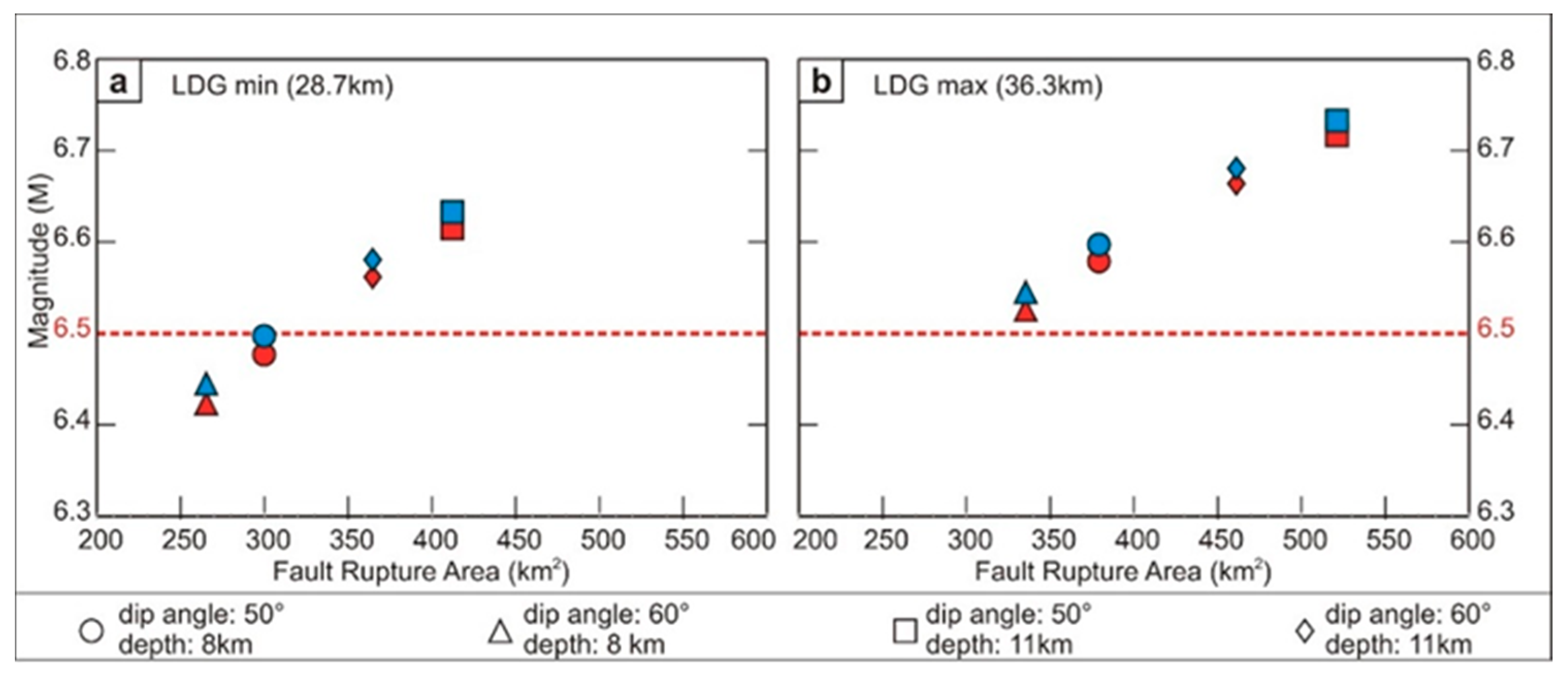
| Orbit | Sensing Date and Time (UTC) | Reference Period |
|---|---|---|
| 22 Descending | 02 September 2016, 05:11:44 | T1 start |
| 22 Descending | 26 September 2016, 05:11:18 | T1 end, T2 start |
| 22 Descending | 26 October 2016, 05:10:43 | T2 end |
| 117 Ascending | 27 August 2016, 17:05:43 | T1 start |
| 117 Ascending | 26 September 2016, 17:05:11 | T1 end, T2 start |
| 117 Ascending | 26 October 2016, 17:05:53 | T2 end |
© 2020 by the authors. Licensee MDPI, Basel, Switzerland. This article is an open access article distributed under the terms and conditions of the Creative Commons Attribution (CC BY) license (http://creativecommons.org/licenses/by/4.0/).
Share and Cite
Brozzetti, F.; Mondini, A.C.; Pauselli, C.; Mancinelli, P.; Cirillo, D.; Guzzetti, F.; Lavecchia, G. Mainshock Anticipated by Intra-Sequence Ground Deformations: Insights from Multiscale Field and SAR Interferometric Measurements. Geosciences 2020, 10, 186. https://doi.org/10.3390/geosciences10050186
Brozzetti F, Mondini AC, Pauselli C, Mancinelli P, Cirillo D, Guzzetti F, Lavecchia G. Mainshock Anticipated by Intra-Sequence Ground Deformations: Insights from Multiscale Field and SAR Interferometric Measurements. Geosciences. 2020; 10(5):186. https://doi.org/10.3390/geosciences10050186
Chicago/Turabian StyleBrozzetti, Francesco, Alessandro Cesare Mondini, Cristina Pauselli, Paolo Mancinelli, Daniele Cirillo, Fausto Guzzetti, and Giusy Lavecchia. 2020. "Mainshock Anticipated by Intra-Sequence Ground Deformations: Insights from Multiscale Field and SAR Interferometric Measurements" Geosciences 10, no. 5: 186. https://doi.org/10.3390/geosciences10050186
APA StyleBrozzetti, F., Mondini, A. C., Pauselli, C., Mancinelli, P., Cirillo, D., Guzzetti, F., & Lavecchia, G. (2020). Mainshock Anticipated by Intra-Sequence Ground Deformations: Insights from Multiscale Field and SAR Interferometric Measurements. Geosciences, 10(5), 186. https://doi.org/10.3390/geosciences10050186










